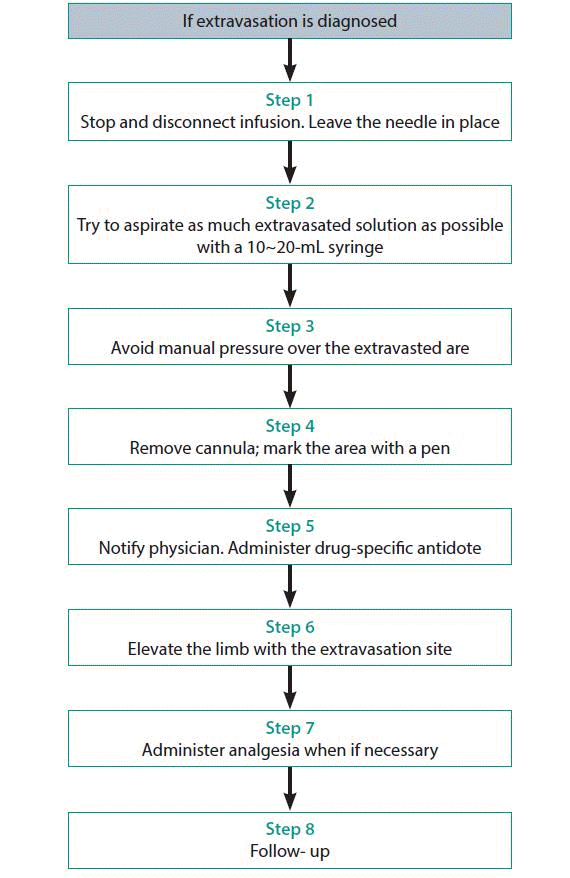1. Drug information: Clinical Computerized Information System: vol. 113. Englewood (CO): Micromedex Inc;[date unknown].
2. BIT Druginfo website [Internet]. Seoul: BIT Druginfo;2020. [cited 2020 Jul 10]. Available from:
http://www.druginfo.co.kr.
3. The National Extravasation Information Service website [Internet]. [place unknown]: The National Extravasation Information Service;2020. [cited 2020 Jul 10]. Available from:
http://www.extravasation.org.uk.
5. Lacy C; American Pharmaceutical Association. Drug information handbook. 8th ed. Hudson (OH): Lexi-Comp Inc;2000.
6. Barton-Burke M, Wilkes GM, Ingwersen KC, Bean CK, Berg D. Cancer chemotherapy: a nursing process approach. 2nd ed. Sudbury (MA): Jones and Bartlett Publishers;1996.
7. Finley RS. Concepts in oncology therapeutics: a self-instructional course. Bethesda (MD): American Society of Hospital Pharmacists;1991.
8. Hadaway L. Extravasation: Issues and Controversies. In : Proceedings of the Infusion Nurses Society Annual Meeting; 1997 May; Salt Lake City, USA. Norwood (MA). Infusion Nurses Society. 1997.
9. Nursing Department, Asan Medical Center. Nursing standard for intravenous injection of Asan Medical Center. Seoul: Asan Medical Center;2007.
10. Yarbro CH, Wujcik D, Gobel BH. Cancer symptom management. 4th ed. Burlington (MA): Jones & Bartlett Learning;2013.
11. Bragalone DL. Drug information handbook for oncology: a complete guide to combination chemotherapy regimens. 12th ed. Hudson (OH): Lexi-Comp Inc;2014.
12. Reynolds PM, MacLaren R, Mueller SW, Fish DN, Kiser TH. Management of extravasation injuries: a focused evaluation of noncytotoxic medications. Pharmacotherapy. 2014; 34:617–632.
https://doi.org/10.1002/phar.1396.

13. Common non-antineoplastic drugs that can act as vesicants or irritants [Internet]. Waltham (MA): UpToDate Inc;c2020. [cited 2020 Jul 10]. Available from:
http://www.uptodate.com.
17. De Wit M, Ortner P, Lipp HP, Sehouli J, Untch M, Ruhnke M, Mayer-Steinacker R, Bokemeyer C, Jordan K. Management of cytotoxic extravasation: ASORS expert opinion for diagnosis, prevention and treatment. Onkologie. 2013; 36:127–135.
https://doi.org/10.1159/000348524.

18. Perez Fidalgo JA, Garcia Fabregat L, Cervantes A, Margulies A, Vidall C, Roila F; ESMO Guidelines Working Group. Management of chemotherapy extravasation: ESMO--EONS clinical practice guidelines. Eur J Oncol Nurs. 2012; 16:528–534.
https://doi.org/10.1016/j.ejon.2012.09.004.

19. Guideline for the management of extravasation of a cytotoxic agent or a monoclonal antibody used in the treatment of malignant disease: version 4.2. Worcester: Worcestershire Acute Hospitals NHS Trust;2015.
20. Sauerland C, Engelking C, Wickham R, Corbi D. Vesicant extravasation part I: mechanisms, pathogenesis, and nursing care to reduce risk. Oncol Nurs Forum. 2006; 33:1134–1141.
https://doi.org/10.1188/06.ONF.1134-1141.





 PDF
PDF Citation
Citation Print
Print





 XML Download
XML Download